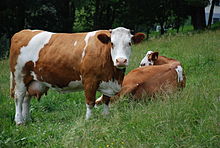 Fleckvieh cows at Rettenbach, in Deutschlandsberg, Styria, Austria Fleckvieh cows at Rettenbach, in Deutschlandsberg, Styria, Austria | |
| Conservation status | not at risk |
|---|---|
| Country of origin |
|
| Distribution | worldwide |
| Use |
|
| Traits | |
| Weight |
|
| Height |
|
| Coat | red pied or solid red |
| Horn status | horned or polled |
| |


The Fleckvieh (German pronunciation: [ˈflɛkfiː] , lit. 'spotted cattle') is a breed of dual-purpose cattle suitable for both milk and meat production. It originated in Central Europe in the 19th century from cross-breeding of local stock with Simmental cattle imported from Switzerland. Today, the worldwide population is 41 million animals.
History
The Fleckvieh originated in the Austrian Empire and the Kingdom of Bavaria from cross-breeding of local stock with Simmental cattle imported from Switzerland from about 1830. The Simmental had good milk-producing and draught qualities, and the resulting crosses were triple-purpose animals with milk, meat, and draught capabilities. The Fleckvieh is now a dual-purpose breed; it may be used for the production of beef or milk, or be crossed with dairy breeds or with beef breeds.
It is reported from several European countries, including Austria, Belgium, Germany, the Netherlands, and Spain, and also, since 2009, from Switzerland; in Hungary, the Fleckvieh is present on many small farms and its importance is growing steadily. It is also reported from other countries of the world, including Australia, Paraguay, Peru, and Uruguay.
Meat production
A comparison was made between the rates of muscle growth and energy use of Fleckvieh bulls as compared to German Black Pied (Schwarzbunte) bulls. The Fleckvieh bulls had faster growth rates, the carcasses had a smaller proportion of fat, especially abdominal fat, and the animals could be slaughtered at an earlier date on similar diets.
References
- ^ Fleckvieh - Dual purpose. Bayern-genetic GmbH. Accessed August 2015.
- ^ Fleckvieh/Austria. Domestic Animal Diversity Information System of the Food and Agriculture Organization of the United Nations. Accessed August 2015.
- "Facts about Fleckvieh". Bayern-Genetik GmbH. Retrieved 2015-08-10.
- Fleckvieh/Belgium. Domestic Animal Diversity Information System of the Food and Agriculture Organization of the United Nations. Accessed August 2015.
- Fleckvieh/Germany. Domestic Animal Diversity Information System of the Food and Agriculture Organization of the United Nations. Accessed August 2015.
- Fleckvieh Fleischnutzung/Germany. Domestic Animal Diversity Information System of the Food and Agriculture Organization of the United Nations. Accessed August 2015.
- Fleckvieh/Netherlands. Domestic Animal Diversity Information System of the Food and Agriculture Organization of the United Nations. Accessed August 2015.
- Fleckvieh/Spain. Domestic Animal Diversity Information System of the Food and Agriculture Organization of the United Nations. Accessed August 2015.
- Swiss Fleckvieh (seit 2009)/Switzerland. Domestic Animal Diversity Information System of the Food and Agriculture Organization of the United Nations. Accessed August 2015.
- M. Guellouz; A. Dimitriadou; C. Masconi (2005). Performance Recording of Animals: State of the Art 2004. Wageningen Academic Pub. pp. 142–. ISBN 978-90-76998-54-1.
- Fleckvieh/Paraguay. Domestic Animal Diversity Information System of the Food and Agriculture Organization of the United Nations. Accessed August 2015.
- Fleckvieh/Peru. Domestic Animal Diversity Information System of the Food and Agriculture Organization of the United Nations. Accessed August 2015.
- Simmental-Fleckvieh/Spain. Domestic Animal Diversity Information System of the Food and Agriculture Organization of the United Nations. Accessed August 2015.
- H. de Boer; J. Martin (6 December 2012). Patterns of Growth and Development in Cattle: A Seminar in the EEC Programme of Coordination of Research on Beef Production held at Ghent, October 11–13, 1977. Springer Science & Business Media. pp. 505–. ISBN 978-94-009-9756-1.
| Cattle breeds of Germany | |||||
|---|---|---|---|---|---|
| These are the cattle breeds considered to be wholly or partly of German origin. Many have complex or obscure histories, so inclusion here does not necessarily imply that a breed is predominantly or exclusively German. | |||||
| |||||
|